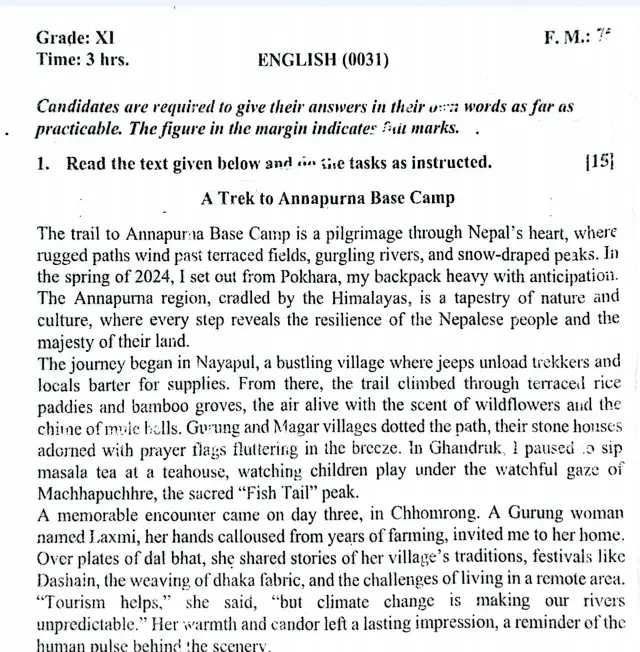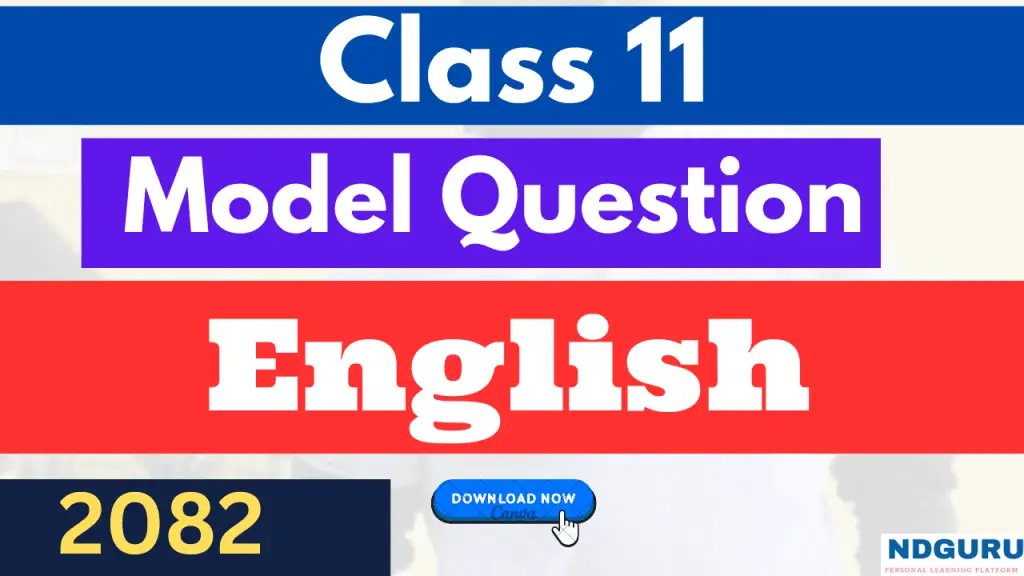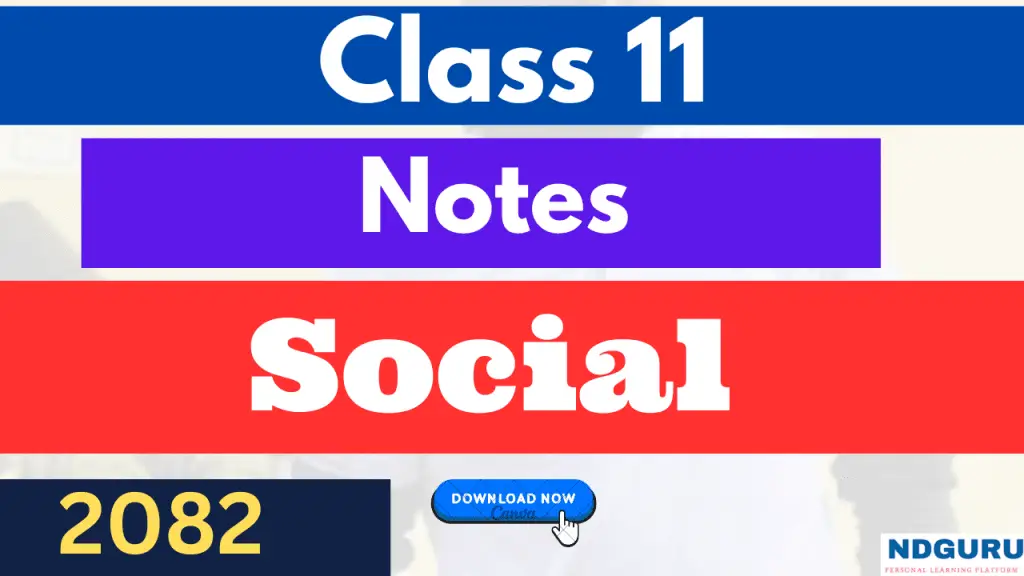Get ready for the NEB Class 11 English exam with this detailed Model Question 2082. Aligned with the Curriculum Development Centre (CDC) guidelines, it covers reading, writing, grammar, and critical analysis. Download the free PDF with solutions below to boost your preparation!

Question Paper Type
Part- A
Unseen Passage (15*1=15)
- Fill in the blanks (5*1=5)
- True and False (5*1=5)
- Question the Answer (5*1=5)
Part-B
Literature
- Answer the Question up to 75 words ( 5*2=10)
- Answer the Question up to 150 words ( 2*5=10)
Part-C
- Free writing -7
- free writing -8
- free writing-10
Part-D
- Grammar (10*1=10)
- Vocabulary (5*1)= 5
Exam Details
- Grade: XI
- Subject: English (0031)
- Time: 3 Hours
- Full Marks: 75
- Instructions: Candidates must give their answers in their own words as far as practicable. The figure in the margin indicates full marks.
Download : Class 11 English Model Question 2082
Complete Class 11 English Model Question 2082
Section A: Reading (15Marks)
1. Read the text below and answer as instructed. [15]
A Trek to Annapurna Base Camp The trail to Annapurna Base Camp is a pilgrimage through Nepal’s heart, where rugged paths wind past terraced fields, gurgling rivers, and snow-draped peaks. In the spring of 2024, I set out from Pokhara, my backpack heavy with anticipation. The Annapurna region, cradled by the Himalayas, is a tapestry of nature and culture, where every step reveals the resilience of the Nepalese people and the majesty of their land.
The journey began in Nayapul, a bustling village where jeeps unload trekkers and locals barter for supplies. From there, the trail climbed through lush terraced rice paddies and bamboo groves, the air alive with the scent of wildflowers and the chime of mule bells. Gurung and Magar villages dotted the path, their stone houses adorned with prayer flags fluttering in the breeze. In Ghandruk, I paused to sip masala tea at a teahouse, watching children play under the watchful gaze of Machhapuchhre, the sacred “Fish Tail” peak.
A memorable encounter came on day three, in Chomrong. A Gurung woman named Laxmi, her hands calloused from years of farming, invited me to her home. Over plates of dal bhat, she shared stories of her village’s traditions, festivals like Dasain, the weaving of dhaka fabric, and the challenges of living in a remote area. “Tourism helps,” she said, “but climate change is making our rivers unpredictable.” Her warmth and candor left a lasting impression, a reminder of the human pulse behind the scenery.
The trek grew tougher as we ascended to Deurali, where the air thinned and the landscape turned stark. Rhododendron forests gave way to alpine meadows, and the peaks of Annapurna South and Hiunchuli loomed closer. At Machhapuchhre Base Camp, the altitude was unforgiving. My head throbbed, and each step felt like wading through molasses. I rested at a lodge, sipping garlic soup, a local remedy for altitude sickness, and marveled at the porters carrying loads twice my weight with ease.
Reaching Annapurna Base Camp at 4,130 meters was euphoric. Surrounded by a 360-degree panorama of peaks, I stood in awe as the morning sun painted the landscape. Yet, the moment was bittersweet. Fellow trekkers spoke of melting glaciers and shrinking snowlines, echoing Laxmi’s concerns about climate change. The descent was a blur of aching knees and quiet reflection. Back in Pokhara, I visited a small shop selling thangka paintings and pashmina shawls, buying a prayer flag to hang at home. The trek had been gruelling but transformative, revealing Nepal’s beauty and its challenges. Laxmi’s words lingered: the land and its people are intertwined, their survival tied to the fragile balance of nature and tradition. I left with a vow to return, hoping the Himalayas would endure for generations to come.
a. Choose and copy the correct answer. [5×1=5] i. What does the word “tapestry” in the first paragraph suggest about the Annapurna region? a) It is a flat plain. b) It is a diverse and rich landscape. c) It is an industrial area. d) It is a desert. Answer: b)
ii. Why did the author feel a “bittersweet” moment at Annapurna Base Camp? a) Due to the cold weather. b) Due to the beauty and concerns about climate change. c) Due to lack of food. d) Due to exhaustion. Answer: b)
iii. Name two specific items or foods mentioned in the passage that the author encountered during the trek. Answer: Masala tea, dal bhat.
iv. Why does the author describe the trek as “transformative”? Answer: It revealed Nepal’s beauty, challenges, and the intertwined survival of land and people.
v. Where did the author begin the trek? Answer: Pokhara.
b. Read the text again and write TRUE/FALSE/NOT GIVEN. [5×1=5] i. The author completed the trek without experiencing any physical difficulties. Answer: FALSE (Head throbbed, steps like wading through molasses.)
ii. The trek to Annapurna Base Camp starts in Ghandruk. Answer: FALSE (Starts in Nayapul.)
iii. Laxmi expressed concerns about unpredictable rivers due to climate change. Answer: TRUE.
iv. The author bought a thangka painting and a pashmina shawl in Pokhara. Answer: NOT GIVEN (Bought a prayer flag.)
v. The passage mentions that Machhapuchhre is a religious peak. Answer: TRUE (Sacred “Fish Tail” peak.)
c. Answer the following questions. [5×1=5] i. What is the main purpose of the passage? a) To promote tourism in Nepal. b) To narrate the author’s trekking experience in the Annapurna region. c) To analyze the impact of climate change on the Himalayas. d) To describe the history of Gurung culture. Answer: b)
ii. How does the author feel upon reaching Annapurna Base Camp? Answer: Euphoric yet bittersweet.
iii. What does the author highlight about Laxmi’s community? Answer: Their traditions, festivals, weaving, and challenges in remote living.
iv. Why does the passage suggest the scenery changes as the trek progresses? Answer: From lush fields to stark alpine meadows due to altitude.
v. How does the author’s interaction with Laxmi influence the narrative? Answer: It adds a human element, emphasizing warmth and cultural resilience.
2. Match the following words with their meanings. [5] a. Resilience – i) Charm b. Tapestry – ii) Endurance c. Unforgiving – iii) Harsh d. Euphoric – iv) Rich variety e. Candor – v) Frankness Answers: a-ii, b-iv, c-iii, d-? (Euphoric: Joyful), e-v
Section B: Writing (25 Marks)
3. Write a letter to the principal requesting permission to organize an inter-school essay competition on “The Role of Youth in Nation Building in the 21st Century.” [10] (Include reason, date, benefits. Word limit: 150-200) Sample: Dear Principal, I am [Name], Class XI student. I request permission for an essay competition on [theme] on [date, e.g., Kartik 15]. This will enhance writing skills and awareness. It benefits students by fostering leadership. Thank you. Sincerely, [Name].
4. Suppose you are the chief guest at a district-level sports meet. Write a speech highlighting the major events, chief guests, and student participation. [7]
5. Write an email to the principal requesting permission for an inter-class speech competition on “The Impact of Social Media on Students.” [5] (Mention theme, date, benefits.)
6. Personal commitment towards building a better Nepal. Write an essay. [3]
Section C: Grammar (30 Marks)
7. Do as instructed. [10×1=10] a. She speaks English ______ (fluent/fluently). Answer: fluently b. Neither the teacher nor the students ______ interested in the topic. (is/are) Answer: are c. You went ______ finish your homework (in order to / into). Answer: in order to d. They ______ (watch) TV when we arrived. Answer: were watching e. I will call you ______ I arrive. (as soon as / while) Answer: as soon as f. The movie ______ (start) by the time we arrived. Answer: had started g. She likes people ______ (who / which) are honest. Answer: who h. The book ______ (write) by the author last year. Answer: was written i. He asked me ______ (where / that) I was going. Answer: where j. If it ______ (rain), we will stay home. Answer: rains
8. Change into indirect speech. [5×1=5] a. She said, “I am learning French.” Answer: She said that she was learning French. b. He said to me, “Where do you live?” Answer: He asked me where I lived.
9. Identify the word class. [5] a. Write the antonym of “prose.” Answer: Poetry b. Add suitable prefix to “possible.” Answer: Impossible
10. What does the idiom “hit the books” mean? [2] Answer: To study hard.
11. From which word is “development” derived? [1] Answer: Develop.
12. Good luck! [2] (Word class: Interjection)
Detailed Solutions & Question Pattern
- Reading (20%): 15 marks on passage + 5 on vocab. Pattern: MCQs (30%), T/F (30%), Short answers (40%).
- Writing (33%): Letters/emails (15 marks), Speech/essay (10 marks). Focus: Structure, vocabulary.
- Grammar (40%): Tenses/voice (10 marks), Speech (5 marks), Vocab/idioms (15 marks). Practice transformations daily.
Class 11 English Guide Nepal 2082: Key Tips
- Syllabus Focus: Units from English Book XI – Reading texts, Writing tasks, Grammar rules.
- Scoring Strategy: Allocate 45 min reading, 60 min writing, 75 min grammar.
- Resources: Pair with Golden English Guide or NDGURU notes for deeper insights.
Free PDF Downloads
- Full Model Paper 2082: Download CDC PDF
- Solutions & Guide: Download Here
- All Subjects Models: Bundle PDF
For more: Visit NEB Official or CDC Portal.
FAQs on Class 11 English Model Question 2082
Q1: What is the main purpose of the passage “A Trek to Annapurna Base Camp” in the model question? A: The main purpose is to narrate the author’s trekking experience in the Annapurna region, highlighting the natural beauty, cultural encounters, and challenges like climate change.
Q2: How much time is allotted for the Class 11 English exam, and what are the total marks? A: The exam duration is 3 hours, with a total of 75 marks.
Q3: What types of tasks are included in the reading section of the model paper? A: The reading section includes multiple-choice questions, true/false statements, and open-ended questions based on the passage “A Trek to Annapurna Base Camp.”
Q4: How can students prepare for the grammar section of the Class 11 English paper? A: Focus on practicing tenses, passive voice, reported speech, punctuation, and sentence transformation (e.g., active to passive) using exercises like those in the model paper.
Q5: Where can I find the complete Class 11 English Model Question 2082 with solutions? A: You can download the full paper with solutions from official NEB resources or educational websites like example.com/class-11-english-model-2082.pdf (replace with actual link if available).
Related Posts from NDGURU
- Class 12 English Model Question 2082
NDGURU presents a full model question paper of Class 12 English 2082 with step-by-step solutions, covering passage, grammar, vocabulary, literature, etc. NDGURU - BBS 1st Year Business English Model Question 2082
A complete guide with syllabus, PDF download, sample answers for the BBS Business English (MGT 201) model question of 2082. NDGURU+1 - NEB Class 12 Optional English Model Questions 2082
A post specially designed for NEB Class 12 Optional English, including downloadable PDF and exam tips. NDGURU - English Notes — All Chapters / One Shot Revision
NDGURU has a section for English where they provide notes, video lectures, and “one-shot revision” materials for English. NDGURU - NDGURU Blog Section — English / Nepali / Account / Others
Their blog covers various subjects: English, Nepali, Account, etc. You can browse there for topic ideas or link to allied subjects. NDGURU


